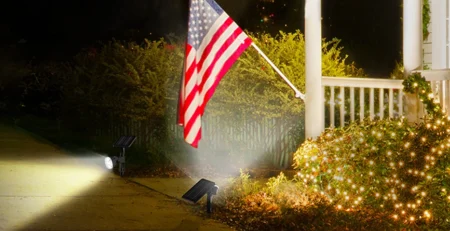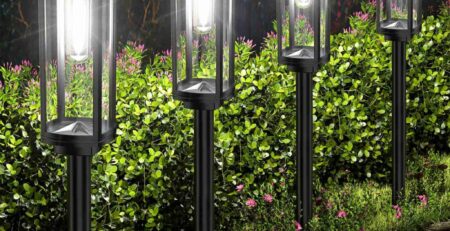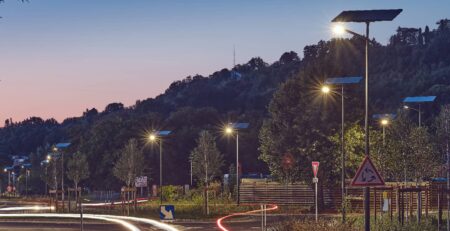Common Mistakes When Using Solar Lights and How to Fix Them
Solar lights have become increasingly popular for homeowners and outdoor enthusiasts alike. These eco-friendly lighting solutions not only add a touch of charm to your outdoor spaces but also help reduce energy costs. However, to fully enjoy the benefits of solar lights, particularly decorative solar lights, it’s crucial to avoid common mistakes that can hinder their performance. In this comprehensive guide, we’ll talk about these pitfalls and provide practical solutions to ensure your solar lights shine brightly for years to come.
Improper Placement: Maximizing Solar Exposure
One of the most prevalent mistakes when using solar lights is improper placement. Solar lights rely on sunlight to charge their batteries, so positioning is key to their effectiveness. Many users unknowingly place their lights in areas that don’t receive adequate sunlight, leading to suboptimal performance.
To address this issue, consider the following tips:
- Analyze sun patterns: Observe your yard throughout the day to identify areas that receive the most sunlight. Ideal spots for solar lights should have at least 6-8 hours of direct sunlight daily.
- Avoid shade: Keep solar panels away from trees, buildings, or other structures that cast shadows. Even partial shade can significantly reduce charging efficiency.
- Adjust seasonally: The sun’s path changes throughout the year. What might be a sunny spot in summer could be shaded in winter. Be prepared to relocate your lights as seasons change.
- Utilize reflective surfaces: If your yard has limited sunny areas, consider placing solar lights near reflective surfaces like light-colored walls or fences. These can help bounce additional light onto the solar panels.

Neglecting Maintenance: Keeping Your Solar Lights in Prime Condition
Another common mistake is neglecting the maintenance of solar lights. While these fixtures are designed to be low-maintenance, they still require some care to function optimally. Ignoring regular upkeep can lead to reduced performance and a shorter lifespan for your solar lights.
Here are some essential maintenance tasks to keep your solar lights, including decorative solar lights, in top condition:
- Clean regularly: Dust, dirt, and debris can accumulate on solar panels, reducing their ability to absorb sunlight. Gently clean the panels with a soft, damp cloth every few weeks. For stubborn grime, use a mild soap solution, but avoid abrasive cleaners that could scratch the surface.
- Check for damage: Periodically inspect your solar lights for signs of wear and tear. Look for cracks in the housing, loose connections, or water ingress. Address any issues promptly to prevent further damage.
- Trim surrounding vegetation: Keep plants and bushes trimmed around your solar lights to prevent them from obstructing sunlight or interfering with the light’s operation.
- Protect during extreme weather: If you live in an area prone to severe weather, consider bringing portable solar lights indoors during storms or heavy snowfall. For fixed installations, ensure they’re securely anchored and designed to withstand local weather conditions.
- Replace batteries when necessary: While solar lights use rechargeable batteries, these will eventually wear out. If you notice decreased performance, it might be time to replace the batteries. Consult your product manual for instructions on how to do this safely.
Overlooking Quality: Investing in Durable Solar Lighting Solutions
A third critical mistake many people make is overlooking the importance of quality when purchasing decorative solar lights. The market is flooded with cheap, low-quality options that may seem attractive due to their low price point. However, these inferior products often lead to disappointment, with dim lighting, short battery life, and poor durability.
To avoid this pitfall, consider the following when choosing solar lights:
- Research reputable brands: Look for manufacturers with a proven track record in solar lighting technology. Companies like BITPOTT, which specialize in new energy applications, often offer superior products backed by extensive research and development.
- Check specifications: Pay attention to key specifications such as lumens (brightness), battery capacity, and the type of solar panel used. Higher-quality lights typically offer better performance in these areas.
- Read customer reviews: While not infallible, customer reviews can provide valuable insights into the real-world performance and durability of solar lights.
- Consider warranty and support: Quality manufacturers stand behind their products with solid warranties and customer support. This can be especially important for more complex decorative solar lights.
- Evaluate materials: Look for solar lights made from durable, weather-resistant materials like high-grade plastics or metals with protective coatings. These will better withstand the elements and last longer.
- Assess design features: Quality solar lights often include thoughtful design elements like adjustable solar panels, multiple lighting modes, or motion sensors. These features can enhance functionality and user experience.
By avoiding these common mistakes – improper placement, neglecting maintenance, and overlooking quality – you can significantly enhance your experience with solar lights. Whether you’re using them to illuminate pathways, accentuate landscape features, or create a cozy ambiance on your patio, proper care and selection of your solar lights will ensure they serve you well for years to come.
As you navigate the world of solar lighting, consider exploring the range of innovative products offered by companies like BITPOTT. With their focus on new energy applications and commitment to quality, they provide solar lighting solutions that combine aesthetics with cutting-edge technology. From solar wall lights to decorative solar lights, their products are designed to meet diverse outdoor lighting needs while prioritizing efficiency and durability.
Conclusion
Solar lights, particularly decorative solar lights, offer a beautiful and eco-friendly way to illuminate your outdoor spaces. By avoiding common mistakes such as improper placement, neglecting maintenance, and compromising on quality, you can ensure your solar lights perform optimally and enhance your outdoor areas for years to come.
If you’re looking to upgrade your outdoor lighting with high-quality solar solutions or have questions about solar lights, don’t hesitate to reach out to experts in the field. For more information or personalized advice on solar lighting options, you can contact BITPOTT at info@forigat.com. Their team of specialists can help you navigate the world of solar lighting and find the perfect solutions for your outdoor illumination needs.
References
- U.S. Department of Energy. (2021). “Solar Lighting Basics.” Office of Energy Efficiency & Renewable Energy. https://www.energy.gov/eere/solar/solar-lighting-basics
- National Renewable Energy Laboratory. (2022). “Solar Radiation Basics.” https://www.nrel.gov/research/re-solar.html
- International Dark-Sky Association. (2020). “Outdoor Lighting Basics.” https://www.darksky.org/our-work/lighting/lighting-for-citizens/lighting-basics/
- American Lighting Association. (2022). “Outdoor Lighting Guide.” https://www.americanlightingassoc.com/resources/outdoor-lighting
- Solar Energy Industries Association. (2023). “Solar Technology.” https://www.seia.org/initiatives/solar-technology


-1-450x231.webp)








Leave a Reply